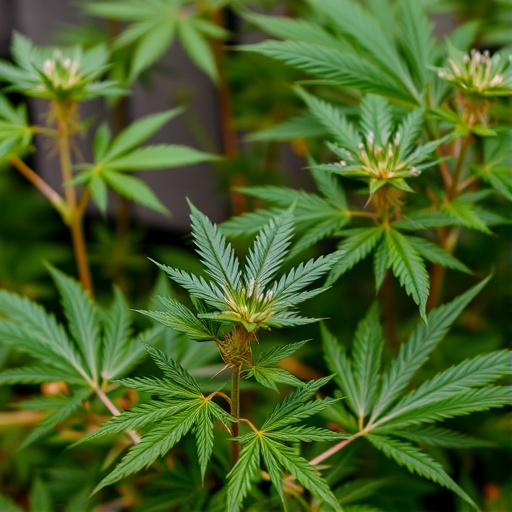A groundbreaking advancement from researchers at the University of Nevada, Las Vegas (UNLV) has unveiled a novel class of cannabidiol (CBD)-like compounds derived from the common kitchen spice caraway seeds. This innovative approach promises a revolutionary leap forward in seizure therapy, particularly for childhood seizure disorders, by offering treatments that are safer, more potent, and more cost-effective than current frontline medications. The cornerstone of this discovery lies in the chemical manipulation of carvone, the principal constituent of caraway seeds, to craft synthetic molecules that mimic the therapeutic advantages of CBD while eliminating the psychoactive effects tied to THC.
Cannabidiol has long been recognized for its non-intoxicating profile and therapeutic potential across an array of neurological and inflammatory conditions, from anxiety to multiple sclerosis and notably, epilepsy. Despite widespread interest, the accessibility of cannabis-derived CBD medications remains restricted due to regulatory challenges, manufacturing complexities, and insurance intricacies. Epidiolex stands as the only FDA-approved CBD-based drug for seizure management in young children, yet is limited to severe epilepsy variants. The UNLV research, however, circumvents these hurdles by synthesizing CBD analogs from carvone, an abundant and THC-free natural compound found not only in caraway but also in dill and spearmint.
The study, published in the esteemed Neuropsychopharmacology journal, details how the chemical structure of carvone was altered to create enantiomers—mirror-image molecules—that exhibit pronounced anticonvulsant properties. These carvone-derived cannabinoids act robustly against seizures in preclinical models, outperforming traditional benzodiazepines, which, despite being widely prescribed for developmental epilepsy, are notorious for their sedative side effects and detrimental impacts on brain development over long-term use.
This innovative therapeutic design strategically targets seizure activity without compromising cognitive function or inducing sedation. The synthesized molecules not only thwart seizures and reduce mortality associated with seizures but intriguingly also support healthier neural development in the brain. This dual functional benefit is particularly crucial in pediatric epilepsy, where ongoing seizures and the toxicity of current drugs can significantly impair cognitive growth and quality of life.
Central to the success of this project were UNLV psychology undergraduates collaborating intricately with faculty experts and partners from New Mexico State University. Their collective efforts culminated in a comprehensive library of carvone-based CBD analogs that open new frontiers in drug discovery. By leveraging carvone’s natural molecular scaffold, the scientists have sidestepped many regulatory bottlenecks associated with cannabis, maximizing the potential for streamlined clinical translation and mass production.
The significance of this advancement extends beyond its potent anticonvulsant efficacy. The synthetic nature of these compounds means they can be manufactured with precision, ensuring consistent quality and eliminating the variability that often plagues plant-derived substances. This scalability could dramatically improve the affordability and accessibility of effective seizure medications worldwide—a vital consideration given the global burden of epilepsy, particularly in resource-limited settings.
Despite such promising preclinical results, the researchers emphasize that these findings represent an initial step on the path toward clinical application. Rigorous human clinical trials remain a crucial hurdle ahead to validate safety, tolerability, and efficacy in diverse patient populations. However, the foundational chemistry and biological activity uncovered set the stage for a new paradigm in epileptic treatment: one anchored in plant-inspired molecular design yet freed from the constraints of cannabis regulation.
Importantly, the team cautions against any simplistic assumptions about consuming caraway seeds directly for seizure control. The raw seeds lack CBD themselves, instead providing a chemical scaffold—the carvone molecule—from which effective cannabinoid analogs can be synthesized. This distinction underscores the sophistication of the synthetic chemistry employed, as well as the necessity of dedicated pharmaceutical development rather than dietary supplementation.
Looking forward, the collaborative research effort continues vigorously. Student researchers, driven by aspirations in neuroscience and medicine, alongside faculty and external partners, remain focused on optimizing these molecules and exploring their mechanisms of action in finer detail. Their pursuit aligns with a broader mission to expand therapeutic arsenals for children who remain refractory to existing treatments, often suffering devastating physical and cognitive outcomes.
This pioneering work not only advances the scientific understanding of CBD-like molecules but also exemplifies the transformative potential of interdisciplinary science: combining chemistry, pharmacology, developmental neuroscience, and clinical insight to address a critical unmet medical need. If successful through clinical phases, these carvone-derived compounds could inaugurate a new era of seizure management marked by enhanced efficacy, improved safety profiles, and accessible treatment options for families worldwide.
In summary, the UNLV team’s synthesis and evaluation of carvone-based cannabidiol enantiomers propel the frontier of anticonvulsant drug discovery. By harnessing a familiar natural substance in an entirely novel way, they have created a promising therapeutic candidate capable of overcoming many limitations of current seizure medications. This innovative molecular strategy, published in September 2025, offers hope for more effective, side-effect-free interventions that not only suppress seizures but also foster healthy brain development in vulnerable pediatric populations.
Subject of Research: Development of novel cannabidiol-like synthetic compounds derived from carvone for anticonvulsant therapy.
Article Title: Carvone derived cannabidiol enantiomers as novel anticonvulsants
News Publication Date: 24-Sep-2025
Web References:
https://www.nature.com/articles/s41386-025-02220-1
http://dx.doi.org/10.1038/s41386-025-02220-1
References:
Hines, D., Carrillo, A., Hines, R.M., Contreras, A., Paton, A., Tenorio, A.J., Maio, W.A. (2025). Carvone derived cannabidiol enantiomers as novel anticonvulsants. Neuropsychopharmacology. https://doi.org/10.1038/s41386-025-02220-1
Keywords: Epilepsy, Carvone, Cannabidiol, Drug discovery, Anticonvulsants, Developmental neuroscience, Synthetic cannabinoids, Benzodiazepine alternatives, Pediatric seizure therapy, Pharmacology, Enantiomers, Drug development




